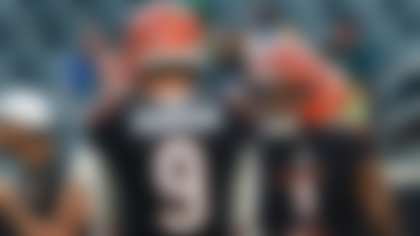NFL franchises use contextualized data to create competitive advantages. In order to realize an edge, teams need to employ the right data in the right way at the right time. This means distilling, interpreting and applying only the most influential data in a framework that accounts for personnel, opponents and evolving game situations. My goal is to be your analytics department. Each week this season, I want to work for you by giving you a peek into which numbers flag in my models as the most impactful ... or the most misunderstood.
As always, let me know if your eye test is picking up on something interesting, or if there's a stat/trend you'd like me to take a deeper look at. You can hit me on Twitter @CFrelund. As with any great analytics department, the more collaborative this is, the more value we can create.
Happy playoffs! We made it! All 256 regular-season games were played. I don't know about you, but I count that as really special -- a testament to what a great plan and excellent execution can do. And now we get to enjoy an expanded postseason tournament.
With the increase to seven teams in each conference's playoff field, only one on each side receives a bye. Consequently, that coveted off week becomes an even bigger factor in my models when it comes to projecting who will make it to (and win) the Super Bowl. In the past, the top two teams from each conference often comprised more than 60 percent of the "make it to the Super Bowl" pie, with the difference between them being huge if it was even five percent. This season, in the AFC, the bye nearly doubles the Chiefs' chances versus the next-closest team (Bills). The NFC is a bit different, but that's due, in part, to the Packers suddenly losing a star at a key position (left tackle David Bakhtiari) and the Saints getting one back (wide receiver Michael Thomas).
So, what do my models project? Here's a quick look at all 14 teams' percentage chances of reaching -- and winning -- Super Bowl LV:
I've become really interested in measuring how quarterbacks perform when they're throwing off platform. In other words, when their body or stance isn't set in the most optimal throwing position (legs, hips, shoulder, arm alignment). My overall premise is that success in this area is part of how the position is evolving in the NFL, based on college trends (the supply of new-school QBs) and pro play-callers leveraging these physical attributes. SPOILER ALERT: Patrick Mahomes is ridiculous off platform. Thus far, I have only measured five full seasons, so consider this a preview of some articles/findings to come. But when throwing off platform, Mahomes is nearly four percent more accurate in terms of completion percentage than any other QB who attempted at least 50 off-platform passes in this span. (The Chiefs QB sits at 65.9, while Deshaun Watson ranks second at 62.0.) This is more of a cool note than a super-predictive one, because I will give you more on Kansas City after its bye, but it is worth noting that the Chiefs' Lombardi Trophy win percentage is exactly the same as the Bills' chance to reach the Super Bowl, which exemplifies how valuable that bye is this season in the AFC.
Had the Packers not lost left tackle David Bakhtiari to a season-ending injury, their "reach the Super Bowl" odds would have been about four percent higher, and their SB win projection would've been around two percent north of the current mark. Those might not seem like huge changes at first blush, but look at some of the differences between other teams' chances (e.g., when it comes to reaching Super Bowl Sunday, the Bucs and Seahawks are separated by just 0.7 percent) and you'll have some context for how much Green Bay will miss its star blocker. According to Pro Football Focus, Bakhtiari allowed just one sack and nine pressures over 446 pass-blocking snaps. Keeping Aaron Rodgers from situations where turnovers are more likely to occur will be a key factor in the Packers' postseason potential, and they'll have to work around this massive loss.
Combining Michael Thomas' return with Drew Brees' increased health gives New Orleans an SB win percentage nearly as high as Green Bay's, despite the fact that the Packers have a first-round bye. Thomas' impact helps boost the efficiency of Alvin Kamara -- and vice versa. The combination of excellent offensive line play and Kamara's elusiveness has driven the running back's inside-the-tackles average to 6.6 yards per rush, which ranks first in the NFL (Next Gen Stats). Funny enough, 12 of his 16 rushing touchdowns came on outside runs, where he averaged just 3.9 yards per rush.
Remember that off-platform quarterback study I mentioned above (and will likely mention quite a bit, going forward)? Well, Josh Allen's improvement in that area this season has been a big contributing factor to his overall increase in completion percentage. He's completing 58.2 percent of those throws this season, compared with 47.3 in 2018 and '19 combined. Furthermore, Next Gen Stats provide some clues about how the Bills' scheme has changed, putting Allen in the best position to succeed. First, his 8.8 air-yards-per-attempt figure is the lowest in his career (was 9.4 in 2019 and 11.0 in '18). Don't get me wrong: 8.8 isn't a low number, it's just lower, and therefore represents Allen throwing more higher-probability passes. It tracks that his deep-pass percentage of 11.2 is the lowest of his career (13.7 and 18.1 previously). Buffalo's scheme also helps in that Allen's open-throw percentage is the highest of his career at 49.5 percent (up from 41.1 and 39.7 in his first two years).
For good reason, a lot has been made of Tom Brady's increased ability to complete deep passes in recent games. His overall regular-season numbers on these throws of 20-plus air yards, per Next Gen Stats: 12.5 yards per attempt, 35.2 completion percentage and a 98.6 passer rating, with nine touchdowns and four interceptions. But one other way to look at this is through the lens of TB12's pass catchers. Mike Evans leads the team with 10 deep receptions and three touchdowns. Overall, NGS shows that Brady's deep targets average 2.3 yards of separation, have seen 66 targets and caught 25 balls for 895 yards -- all of these marks rank third (or tied for third) among NFL receiving corps. Eight of those connections went for touchdowns, which is tied for seventh-most.
Russell Wilson has been pressured on 24.5 percent of dropbacks this season, which is about league average at 14th-lowest -- but it's also the lowest rate Wilson has faced in the past five seasons. Russ has the best touchdown-to-interception ratio when under pressure in the NFL this season (8:0) and the second-best passer rating (94.7). Since Seattle's Week 6 bye, Wilson's deep-passing efficiency has been far less reliable than during his red-hot start, with a 56.5 completion percentage plummeting to 29.5, an 8:0 TD-to-INT ratio dropping to 5:4 and a 140.9 passer rating disintegrating to 70.6.
Measuring performance when a quarterback is not under pressure gives a good and defensible proxy for the best a passer can offer in an optimal setting. Yes, a QB's production is reliant on his receivers' play, too, but the pressure-free environment is one of the best in-game measuring sticks we have. Next Gen Stats show that over his past five games, Ben Roethlisberger struggled passing when not under pressure ... until the second half of Week 16. In Week 12 through the first half of Week 16, Big Ben compiled the following figures when not under pressure: 63.6 completion percentage, 5.1 yards per attempt, 6:4 TD-to-INT ratio, 78.3 passer rating. But in the second half of Week 16, this is what the 38-year-old QB did when pressure-free: 76.9 completion percentage, 8.4 yards per attempt, 3:0 TD-to-INT ratio, 139.7 passer rating.
Pro Football Focus shows that the Rams have two corners in the top five in completion percentage allowed and three in the top 10 in passer rating allowed. Jalen Ramsey and Darious Williams are both tied for the second-lowest completion percentage of passes in their coverage at 50.0. And when it comes to passer rating allowed, Williams (59.9), Ramsey (73.0) and Troy Hill (74.3) are all spectacular. The front and back of defenses work together, though, so I can't pass up an opportunity to point out that Aaron Donald, again, paces all interior defenders in QB pressures (71), pressure rate (13.9), sacks (13.5), turnovers caused by pressure (3, this one is a tie) and pass-rush get-off (0.86 seconds).
Since Week 13, Lamar Jackson's been quite prolific on passes of 10-plus air yards. In Weeks 1 through 11, he completed just 44.3 percent of these throws, averaging 8.7 yards per attempt. In Weeks 13 through 17, those numbers jumped to 60 percent and 13.5 ypa. He has also improved against the blitz over this time period, going from 61.7 percent completions and 5.8 yards per attempt to 73.7 percent and 13.9 ypa. His passer rating in Weeks 13-17 against the blitz? A whopping 155.2.
En route to becoming just the eighth player in NFL history to rush for 2,000 yards in a season, Derrick Henry powered through stacked boxes (eight-plus defenders) to the tune of 5.9 yards per attempt (second-best in the NFL) with 10 touchdowns (league high). He also led the NFL in yards earned over expected for the second straight season at +412. This works hand in glove with Tennessee's play-action passing game, in which Ryan Tannehill has averaged 11.1 yards per attempt over the past two seasons -- the best mark in the NFL over that time frame. The red flag here is the Titans' defense, which has only been able to generate pressure at a 15.9 percent rate -- the lowest figure in the NFL, per Next Gen Stats.
The Colts have pressured opposing quarterbacks on 26.4 percent of dropbacks, which is the 11th-highest rate in the NFL, per NGS. Notably, Indy has managed to do so without leveraging the blitz, as the Colts have only used that tactic on 19.1 percent of dropbacks (second-lowest rate in the league). The Colts are one of three teams to not allow a touchdown pass when generating pressure without blitzing. DeForest Buckner ranks fifth in quarterback pressures among interior defenders (44) and fourth in sacks (9.5).
According to Next Gen Stats, when Mitchell Trubisky is under pressure, he has the lowest completion percentage (32.4) with the fewest yards per attempt (3.1) in the NFL. In fact, Trubisky has completed just 11 passes under pressure this season. When operating without pressure, the Bears signal-caller boasts solid figures in both these areas: 71.5 percent completions, 7.4 yards per attempt. It's typical for a quarterback's efficiency to fall under pressure, but Trubisky's drop-off is staggering. The good news: Chicago's scheme has helped mitigate this issue, as Trubisky has been under pressure at the second-lowest rate in the NFL this season (16.5 percent of dropbacks).
Washington finished the regular season with a 29.0 percent pressure rate, seventh-best in the NFL. Likely Defensive Rookie of the Year Chase Young has obviously had a significant impact here, with his on- and off-field splits reflecting as much. When Young's in the game, WFT applies pressure at a 30.3 pressure rate, per NGS. When he isn't, that number drops to 24.6.
Baker Mayfield's passer rating under pressure is 47.1, which ranks 30th in the NFL. Now consider that fact that, in his first playoff game, the third-year QB will be without one of his best offensive linemen, as Joel Bitonio just landed on the reserve/COVID-19 list. Head coach/play-caller Kevin Stefanski also tested positive and will be absent. Oh, and Mayfield's opponent, Pittsburgh, has applied pressure on opposing QBs at an NFL-best rate of 37.3 percent of dropbacks. Add all that up, and you can see why the Browns sit at the bottom of this list. In fact, both of their SB percentages were more than cut in half with this week's COVID developments.
Follow Cynthia Frelund on Twitter.


























